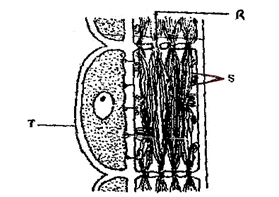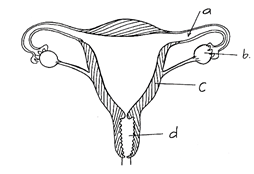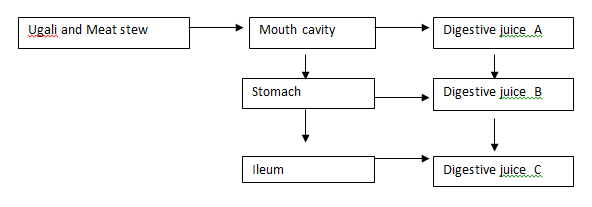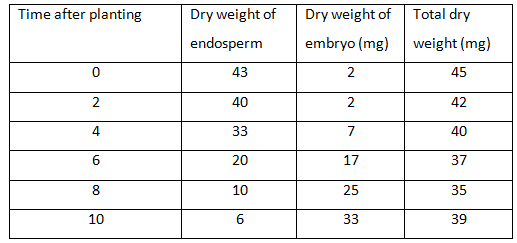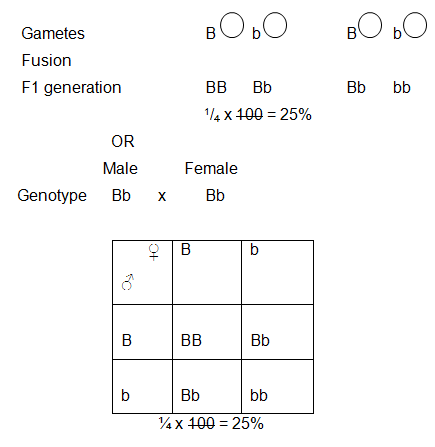INSTRUCTIONS TO CANDIDATES:
- This paper consists of TWO sections A and B.
- Answer all questions in section A in the spaces provided.
- In section B, answer question 6 (compulsory) and either question 7 or 8 in the spaces provided.
SECTION A (40 MARKS)
Answer all questions in this section in the spaces provided.
- The diagram below represents part of phloem tissue.
- Name the structures labeled R and S and the cell labeled T (3mks)
R:
S:
Cell labeled T: - State the function of the structure labeled S. (1mk)
- Explain why xylem is a mechanical tissue. (2mks)
-
- State the effect of removal of the cell labeled T. (1mk)
- Give a reason for your answer in (a) above. (1mk)
- Name the structures labeled R and S and the cell labeled T (3mks)
-
- Describe the following chromosomal mutations:
- Inversion (2mks)
- Translocation (2mks)
- In mice the allele for black fur is dominant to the allele for brown fur. What percentage of offspring would have brown fur from a cross between 2 heterozygous black mice? Show working. Use letter B to represent the allele for black colour.(4mks)
- Describe the following chromosomal mutations:
- Study the diagram below and answer the questions that follow.
-
- Which part marked a, b, c and d, when defective after implantation may lead to abortion (1mk)
- Give a reason for your answer. (1mk)
- The part labeled b can be removed after 4 months of pregnancy without interfering with the pregnancy. Explain. (2mks)
- Under each of the following, state the name of the causative agent.
- Syphillis (1mk)
- Gonorrhea (1mk)
- AIDS
- State two disadvantages of external fertilization. (2mks)
-
- Study the figure below and answer the questions that follow.
- Which solution has higher concentration of free water molecules? (1mk)
- Which solution is more concentrated? (1mk)
- In which direction will osmosis take place? Indicate using an arrow on the diagram. (1mk)
- What does semi-permeable membrane represent in an animal cell (1mk)
-
- Define the term active transport (1mk)
- Why is oxygen important in active transport in cells (2mks)
- When red blood cells are placed in a hypotonic solution they burst.Name the process involved.(1mk)
- The flow diagram below represents passage of a meal through the human digestive system. Study the diagram and answer the questions that follow.
- Name the physical process that will occur in mouth cavity (1mk)
- Name the digestive juices B and C (2mks)
- Explain two ways in which the digestive system is protected from corrosive effects of digestive juices. (2mks)
- Name the hormone that stimulates secretion of juice B. (1mk)
- Identify two contents of digestive juice A (2mks)
SECTION B – 40 MARKS
Answer question 6 (Compulsory) and any other one question from this section.
- During germination and growth of a cereal, the dry weight of endosperm, the embryo and total dry weight were determined at two-day intervals. The results are shown in the table below.
- Using the same axes, draw graphs of dry weight of endosperm, embryo and the total dry weight against time. (8mks)
- What is the total dry weight on day 5? (1mk)
- Account for:
- Decrease in dry weight for endosperm from day 0 to 10. (2mks)
- Increase in dry weight of embryo from day 0 to 10. (2mks)
- Decrease in total dry weight from day 0 to day 8. (2mks)
- Increase in total dry weight after day 8. (1mk)
- State one cause of dormancy: (2mks)
- Within a seed
- Outside the seed
- State two ways of breaking seed dormancy (2mks)
- Explain the role of human skin in:
- Thermo regulation. (14mks)
- Protection (6mks)
- Explain various ways in which fruits and seeds are adapted to dispersal. (20mks)

MARKING SCHEME
-
- R - Sieve pore;
S – Cytoplasmic strands / filaments;
Cell T – companion cell; - Translocation;
- They are thickened; and lignified;
-
- Active transport will not occur;
- Reason: Because of lack of energy;
- R - Sieve pore;
-
-
- Inversion
Occurs when chromatids break at two places; and when rejoining the middle piece rotates and joins in an inverted position; - Translocation
- Occurs when a section of chromatid breaks off; and becomes attached to another chromatid of another chromosome;
- Inversion
- Parents ♂ ♀
Parental phenotype Black fur Black fur
Parental genotype Bb x Bb
*Penalise at parental genotype if other letters are used.
*Maximum of 1 mark if wrong symbols used for correct crossing.
-
-
-
- C;
- It is the uterine wall where implantation occurs;
- Part b secretes the hormones oestrogen and progesterone before 4 months of pregnancy; This role is taken over by placenta hence no active role; progesterone and oestrogen maintain pregnancy.
- Treponema pallidum names that are not underlined (i & ii)
- other rules spelling of binomial nomenclature - Neisseria gonorrhoea
- Human immune deficiency virus rej. HIV
- Treponema pallidum names that are not underlined (i & ii)
- gametes are less protected Low chances of fertilization; high rate of predators attacking eggs
-
-
- Solution A;
- Solution B;
- Arrow from A Pointing B;
- Cell membrane / Plasma membrane;
-
- Movement of ions/molecules from where they are lowly concentrated to where they are highly/against conc.gradient by use of energy.
- Oxygen is required in respiration to generate energy/ATP
- Haemolysis
-
- Mastication;/chewing;/grinding; any one (1mk)
- B – Gastric juice; (1mk)
C – Intestinal juice;/ succus entericus; (1mk)
reject wrong spelling - Has Goblet cells that secret mucus: mucus forms a protective barrier
- Enzymes produced in inactive form that is pepsinogen and trypsinogen (2mks) - Gastrin; (1mk)
- – Enzyme salivary amylase.Ptyalin;
- Mucin/Mucus;
- Water; (any two) (2mks)
-
-
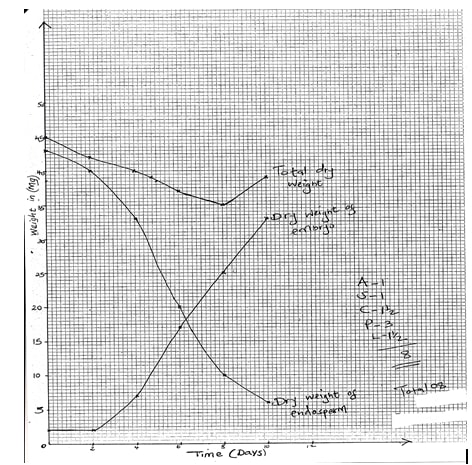
- 5,g Acc + 0.5;
-
- Hydrolysis of starch into simple sugars; which are transported to the embryo;(Respiration to give energy). Accept simple sugars oxidized rej. oxidation of starch.
- New materials are synthesized from protein; bringing about growth of embryo;
- The rate of respiration is faster; than that of synthesis of materials for growth;
- Foliage leaf carried out photosynthesis leading to growth;
-
-
- Presence of absiscic acid / Germination inhibitors;]
- Embryo not fully developed;
- Absence of hormones / enzymes to stimulate germination;
- Impermeable seed coat; rej. hard seed coat. (any one)
-
- Unsuitable / unfavourable temperature;
- Absence of light;
- Lack of water;
- Lack of oxygen; (any one)
-
- scarification
- Allow embryo to mature
- Increase in conc.of hormones eg cytokinins n gibberellins that stimulate germination
- Favourable environmental factors eg water 0xygen and suitable temperature
- Suitable wavelength of light that trigger production of hormones like gibberellins.
-
-
- When the temperature is low (cold), the erector pilli muscles contract; making the hair follicles to stand erect; The hair follicles trap a layer of hair; between them which reduces heat loss due to poor heat conduction through them; when the temperature is high, the erector pilli muscles relax; thus making the hair to lie flat; thus reducing the air trapped and more heat will be lost to the environment; Skin has sweat glands which secrete sweat; when temperatures are high; water from the sweat evaporates; taking away latent heat of vapourization; when temperature is low, no sweat is produced; When temperature is high, the blood vessels vasadilate; and this encourages loss of heat; as more blood flow close to the skin surface; when temperatures are low, blood vessels vasoconstrict; less blood flows close to skin surface; hence less heat is lost to the environment; Skin has an adipose tissue for insulation against heat loss;
- Skin has a cornified layer made of dead cells; which protects the entry of bacteria; and inner tissues from mechanical damage; the sebaceous gland, secret sebum; which has antiseptic properties; hence protects the body from bacteria. The skin has melanin pigment; which protect the body from harmful U.V rays;
- Wind dispersal
- Some seeds / fruits have parachute (hair like structures extending from the seed coat / fruit wall; which increases the surface area for floating in air; to be blown over a long distance e.g. in sow thistle;
- Some seeds have papery extensions (winged seed / fruits); to increase the surface for floating in air so that they can easily be carried by wind; e.g. jacaranda; spatholea sp;
- Some plants have ovaries which are capsule shaped; which on drying up burst open along lines of weakness thus scattering the seed, into the air; This is called censor mechanism e.g. simsim;
- Some seeds are light in weight; to be easily blown by wind;
- Animal dispersal
- Having hooks on the ovary wall or calyx; which stick on the fur / clothes of animals passing by; e.g. black jack fruit; devils horsewhip fruit;
- Being succulent / fleshy; to attract animals to feed on them as the seeds are dispersed;
- Seed, having a hard indigestive seed coat; which passes through the animal’s digestive system undigested; e.g. in Guavas;
- Being brightly coloured when ripe; to attract animals; e.g. oranges, guavas, tomatoes;
- Being large in size and conspicuous; to be seen by animals easily; e.g. oranges;
- Water dispersal
- Having fibrous walls containing many air pockets; for easy floating on water; so that it can
- be carried by water waves / scattered;
- Self dispersal mechanism/explosive mechanism
- Have a line of weakness(suture) that explodes realizing the seeds
- Wind dispersal
Download BIOLOGY PAPER 2 - 2019 KCSE CEKENA MOCK EXAMINATION (QUESTIONS AND ANSWERS).
Tap Here to Download for 50/-
Get on WhatsApp for 50/-
Why download?
- ✔ To read offline at any time.
- ✔ To Print at your convenience
- ✔ Share Easily with Friends / Students

